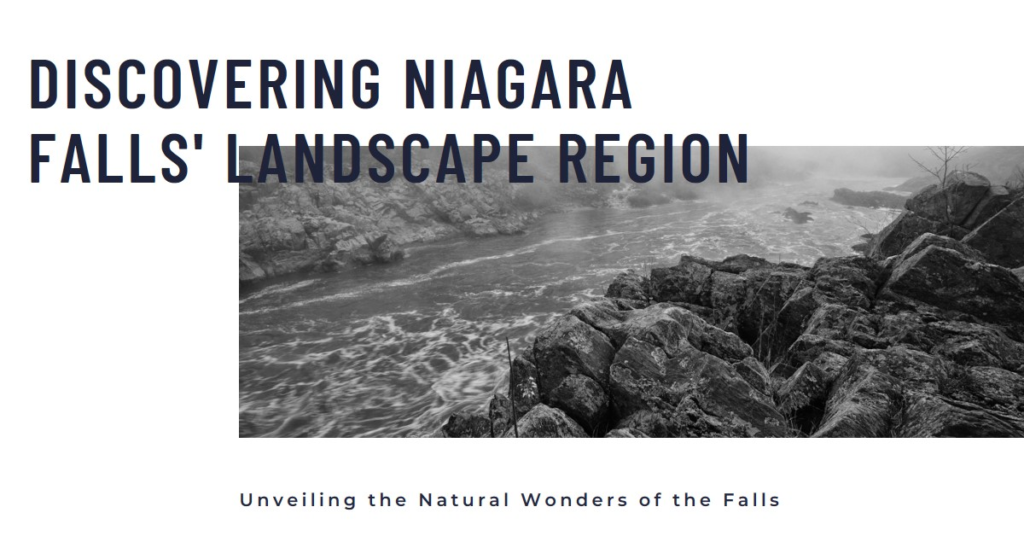
Table of Contents
- Introduction: The Majestic Beauty of Niagara Falls
- The Geographical Setting: Where is Niagara Falls?
- The Niagara Escarpment: Backbone of the Region (Landscape)
- The Formation of Niagara Falls: A Geological Marvel
- The Hydrology of Niagara Falls: Water’s Journey
- Ecological Richness: Biodiversity of the Niagara Region
- Cultural and Historical Significance: A Storied Past
- Tourism and Economic Impact: A Global Attraction
- Environmental Conservation: Protecting the Natural Wonder
- Conclusion: Embracing the Legacy of Niagara Falls
Introduction: The Majestic Beauty of Niagara Falls
Niagara Falls, a breathtaking natural wonder, captivates millions of visitors each year. Its immense power and beauty have earned it a place among the most famous waterfalls in the world. However, beyond its mesmerizing cascades, there lies a rich tapestry of geological and ecological significance. Understanding the landscape region of Niagara Falls requires a journey through the physical and historical aspects that have shaped this iconic site.
The Geographical Setting: Where is Niagara Falls?
Situated on the border between the United States and Canada, Niagara Falls is located in the Niagara Region, spanning both Ontario and New York State. The falls consist of three distinct waterfalls: the Horseshoe Falls, American Falls, and Bridal Veil Falls. This region, nestled between Lake Erie and Lake Ontario, serves as a natural conduit for water flowing from the upper Great Lakes to the lower Great Lakes.
The landscape of this area is characterized by its glacial history. During the last Ice Age, massive glaciers carved out the Great Lakes and the Niagara Escarpment, a prominent geological feature that runs from New York State through Ontario to Wisconsin. The escarpment forms the backbone of the region, providing the elevation difference that gives rise to Niagara Falls.
The Niagara Escarpment: Backbone of the Region (Landscape)
The Niagara Escarpment is more than just a geological formation; it is a UNESCO World Biosphere Reserve, recognized for its unique combination of geological features, diverse ecosystems, and rich cultural history. This escarpment is a long, steep slope or cliff that extends for over 650 miles, influencing the topography of the surrounding landscape.
Formed over millions of years, the Niagara Escarpment consists of layers of sedimentary rock, primarily dolostone and shale. These rock layers were deposited during the Silurian and Ordovician periods, around 400 to 500 million years ago. The differential erosion of these rock layers, where harder dolostone erodes more slowly than softer shale, has created the dramatic cliffs and waterfalls that characterize the escarpment.
The Formation of Niagara Falls: A Geological Marvel
The story of Niagara Falls’ formation is a tale of geological processes that span millennia. Approximately 12,000 years ago, the last of the great glaciers began to recede, and meltwater from these glaciers carved out the Great Lakes and the Niagara River. As the river flowed over the edge of the Niagara Escarpment, it created a waterfall that gradually moved upstream through a process known as headward erosion.
This process involves the erosion of the softer layers of shale beneath the harder dolostone caprock, causing sections of the caprock to collapse and the waterfall to retreat. Over thousands of years, this retreat has shaped the Niagara Gorge, a deep, narrow valley that extends from the current location of the falls to the escarpment’s original edge. The falls continue to erode today, though at a much slower rate due to human intervention and geological stability.
The Hydrology of Niagara Falls: Water’s Journey
Niagara Falls is part of the Niagara River, a 36-mile waterway that connects Lake Erie to Lake Ontario. This river, in turn, is part of the Great Lakes Basin, one of the largest freshwater systems in the world. The Great Lakes contain about 84% of North America’s fresh surface water and around 21% of the world’s supply of fresh water.
The hydrology of the Niagara River is influenced by the enormous volume of water flowing from the upper Great Lakes. On average, about 85,000 cubic feet of water per second flows over Niagara Falls. The flow rate can vary significantly, with higher volumes during peak periods in the spring and lower volumes in the winter when ice control measures are in place.


Ecological Richness: Biodiversity of the Niagara Region
The Niagara Region is a hotspot for biodiversity, boasting a variety of ecosystems that support numerous plant and animal species. The combination of the escarpment, river, and nearby Great Lakes creates a unique environment where species from different ecological zones coexist.
The Niagara Gorge, with its microclimates and varied habitats, is home to rare and endangered plants, including ferns, wildflowers, and ancient tree species. The escarpment’s cliffs provide nesting sites for peregrine falcons and other bird species. Additionally, the Niagara River supports a rich aquatic ecosystem, with fish species such as salmon, trout, and sturgeon.
Cultural and Historical Significance: A Storied Past
The Niagara Region has a rich cultural and historical heritage, with evidence of human activity dating back over 12,000 years. Indigenous peoples, including the Haudenosaunee (Iroquois) and Anishinaabe, have lived in the area for millennia, drawing sustenance and spiritual inspiration from the falls and surrounding landscape.
European exploration and settlement began in the 17th century, with French explorers such as Samuel de Champlain and missionaries documenting the falls. The region later became a strategic military site during the War of 1812, with several key battles fought near the falls. Today, historical landmarks and museums in the area commemorate these events and celebrate the region’s diverse cultural heritage.
Tourism and Economic Impact: A Global Attraction
Niagara Falls is one of the most popular tourist destinations in the world, attracting over 12 million visitors annually. The falls offer a variety of attractions, from boat tours that take visitors to the base of the cascades to observation decks that provide panoramic views. The surrounding area features parks, hiking trails, and cultural sites, enhancing the visitor experience.
Tourism plays a crucial role in the local economy, generating significant revenue and providing jobs for thousands of residents. The hospitality industry, including hotels, restaurants, and entertainment venues, thrives due to the steady influx of tourists. Additionally, the falls serve as a symbol of natural beauty and power, drawing international attention and fostering a sense of pride among locals.
Environmental Conservation: Protecting the Natural Wonder
The ecological health of Niagara Falls and its surrounding region is paramount to its continued allure and significance. Conservation efforts are essential to protect the area’s natural beauty and biodiversity. Various organizations and government agencies collaborate to address environmental challenges, such as water quality, habitat preservation, and invasive species management.
One notable conservation initiative is the Niagara River Corridor Ramsar Site, designated as a Wetland of International Importance. This designation recognizes the river’s critical role in supporting wildlife, including migratory birds and fish species. Efforts to reduce pollution, manage water flow, and restore natural habitats are ongoing, ensuring that Niagara Falls remains a vibrant and healthy ecosystem.
Conclusion: Embracing the Legacy of Niagara Falls
Niagara Falls is more than just a spectacular waterfall; it is a testament to the power of nature and the intricate interplay of geological, hydrological, and ecological processes. Understanding the landscape region of Niagara Falls provides a deeper appreciation for its formation, significance, and the efforts required to preserve it for future generations.
From the towering cliffs of the Niagara Escarpment to the rushing waters of the Niagara River, the region encapsulates the dynamic forces that shape our natural world. As we continue to explore and protect this iconic landmark, we honor its past, embrace its present, and ensure its legacy endures for years to come.


